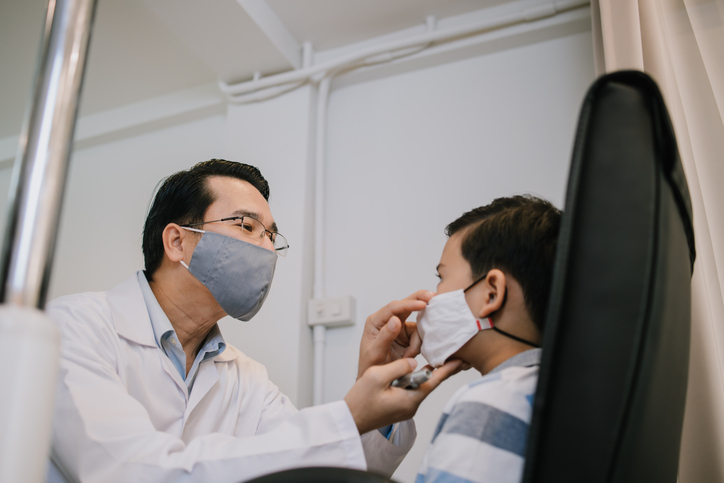
You wake up one morning to find you're having trouble opening your eye, and it's a bit swollen and itchy. There's a good chance you've caught a case of pink eye.
What is Pink Eye?
Pink eye, or conjunctivitis, is an infection in the conjunctiva, a membrane in your eyelids. When blood vessels in the conjunctiva (white part of the eye and inner eyelids) become inflamed, your eye takes on a pink hue.
Is Pink Eye Common?
Yes, pink eye is a widespread eye condition that can affect people of all ages, although it’s more prevalent in young children. Although unsightly and uncomfortable, pink eye usually isn’t serious and often clears up on its own. It is very contagious, however, and spreads easily among the younger population who tend to find it difficult to refrain from touching or rubbing their eyes. Therefore, it's essential to keep your child home from school if they are experiencing inflammation and discharge, and to take them to the doctor if it is not clearing up after a couple days.
Different Types of Pink Eye
There are three main types of pink eye.
-
Allergic Conjunctivitis. This is when someone gets pink eye due to an allergy. Anything from pollen to pet dander triggers this type of pink eye, a form that usually clears up on its own once you've distanced yourself from an allergen for some time.
-
Viral Conjunctivitis. This stems from the common cold. If you're experiencing cold symptoms like coughing or sneezing, you are susceptible to mucous membranes in your eyelids becoming inflamed.
-
Bacterial Conjunctivitis. This form of pink eye comes from poor hygiene, sharing cosmetics, or coming in contact with those others who are infected with conjunctivitis.
Other causes of pink eye include blocked tear ducts (in newborns) and chemicals or foreign objects in the eye.
Is Pink Eye Contagious?
If your case of pink eye stems from a bacterial or viral infection (bacterial and viral conjunctivitis), then it's contagious.
Pink Eye Risk Factors
There are a few ways to catch pink eye.
-
Rubbing or touching your eyes with hands that have not been washed.
-
Wearing contact lenses. If you're an extended-use contact lens wearer, you have an increased chance of catching pink eye.
-
Being exposed to someone with pink eye. One of the easiest ways to catch conjunctivitis is by spending time and coming into physical contact with an infected person.
-
Being exposed to an allergen. Another simple way to catch conjunctivitis is by exposure to something you're allergic to.
Pink Eye Symptoms
Allergic conjunctivitis: Symptoms include redness in both eyes and watery discharge. Itching is a key symptom and may help distinguish allergic conjunctivitis from infectious. Patients often have seasonal allergies and associated symptoms such as itchy nose and sneezing. Symptoms may wax and wane based on exposure to the allergen.
Viral conjunctivitis: Usually symptoms begin with clear discharge and burning or gritty feeling in one eye that typically spreads to the second eye in a day or two. Often there are other cold symptoms such as runny nose.
Bacterial conjunctivitis: Symptoms usually include thick discharge. Often the discharge can be seen at the corner of the eye throughout the day. Bacterial conjunctivitis can occur in one or both.
Conjunctivitis is usually not associated with visual disturbance, headaches, or pain in the eyes. If you're feeling any of these in addition to pink eye symptoms, contact your doctor.
Pink Eye Treatments
Allergic conjunctivitis: Usually responds well to antihistamines taken either by mouth or via eye drops. A warm compress (washcloth soaked in warm water) placed gently over the infected eye can help to reduce buildup of discharge on the eyelids and any crust that has formed on your eyelashes. A cold compress (washcloth soaked in cool water) may help relieve itching and inflammation. However, avoid any rubbing of the eye.
Viral conjunctivitis: Antibiotics will not help, and symptoms usually clear up on its own in one or two weeks without medical treatment. Warm compresses and lubricating eye drops may help provide symptomatic relief. You should not be alarmed if symptoms worsen or spread to the other eye in the first few days before improving.
Bacterial conjunctivitis: Antibiotics. A doctor prescribes antibiotic eye drops to help reduce the redness and eliminate the bacteria in the eye in the case of bacterial conjunctivitis. This comes in the form of eye drop or ointment.
Pink Eye Prevention
There are a few reliable ways to prevent pink eye and its potential spread.
-
Washing your hands. As is the standard practice with other viral transmissions, washing your hands with soap and water for 20 seconds is a great way to prevent the spread of pink eye.
-
Don't rub your eyes. Keeping your hands clean, as well as away from your eyes, is a fantastic way to prevent pink eye from appearing in both eyes.
-
Avoid sharing certain items. When you share makeup, towels, washcloths, and even eyeglasses, you increase the risk of spreading pink eye.
A surefire way to prevent pink eye is by practicing good eye hygiene.
Conclusion
Although pink eye is a common infection, it doesn't mean you can't prevent it. Stop pink eye in its tracks by engaging in good eye hygiene, limiting contact with infected individuals, and not sharing cosmetics.
